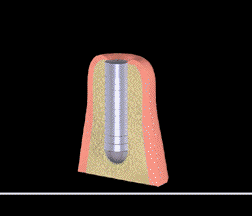Dental Implants
Dental implants are changing the way people live! They are designed to provide a foundation for replacement teeth which look, feel, and function like natural teeth. The person who has lost teeth regains the ability to eat virtually anything and can smile with confidence, knowing that teeth appear natural and that facial contours will be preserved.
What are Dental Implants?
The implants themselves are tiny titanium posts which are inserted into the jawbone where teeth are missing. These metal anchors act as tooth root substitutes. They are surgically placed into the jaw bone. The bone mechanically anchors the titanium through a process known as osseointegration, creating a strong foundation for artificial teeth. Small posts called abutments are then attached to the implant which protrude through the gums. These posts provide stable anchors for artificial replacement teeth.
Implants also help preserve facial structure, preventing the bone deterioration which occurs when teeth are missing.

The Surgical Procedure
For most patients, the placement of dental implants involves only one surgical procedure. First, implants are placed within your jawbone. For the first six weeks following surgery, the implants are gradually bonding with the jawbone. You should be able to wear temporary partial or complete dentures and eat a soft diet during this time. At the same time, your dentist is forming new replacement teeth.
After the implant has bonded to the jawbone, the second phase begins. Your doctor will attach small posts called abutments, which will act as anchors for the artificial teeth. These posts protrude through the gums. When the artificial teeth are placed these posts will not be seen. The entire procedure usually takes three to six months. Most patients experience minimal disruption in their daily life.
